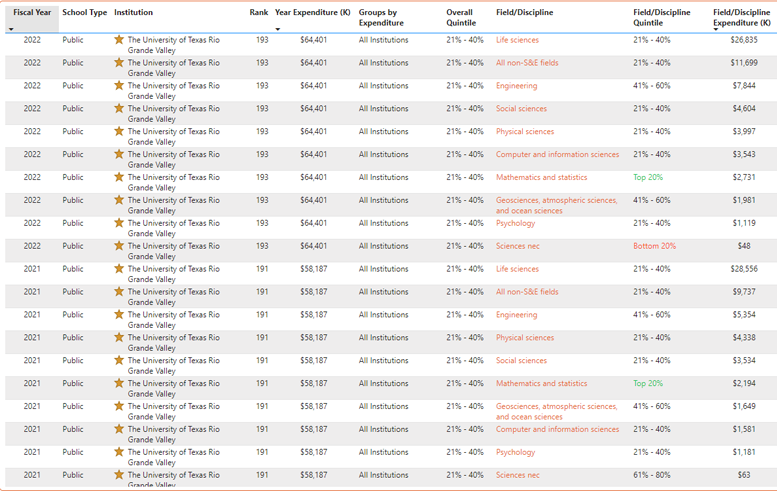Comparative Summary: Benchmarking UTRGV's Research Expenditure Among Peer Institutions
The Comparative Summary page on the NSF HERD Dashboard provides a snapshot of how institutions compare in terms of research spending. By categorizing institutions based on expenditure levels and ranking them within quintiles, this page offers a clear picture of where UTRGV stands relative to its peers and helps track progress over time.
Key Variables and Grouping Criteria
- Groups by Expenditure:
- This variable groups institutions according to the new Carnegie classification criteria:
- Higher than $50 Million: Meets R1 (Research 1) status requirement for Very High Research Activity.
- $5 Million to $50 Million: Meets R2 (Research 2) status requirement for High Research Activity.
- Higher than $5 Million: Includes all institutions with research expenditure exceeding $5 million.
- All Institutions: Includes all institutions regardless of their expenditure level.
- These groups help users quickly identify if UTRGV’s expenditure aligns with the funding levels required for R1 or R2 classification.
- This variable groups institutions according to the new Carnegie classification criteria:
- Quintile Group:
- Institutions are divided into five equal parts (quintiles), each representing 20% of the data, based on yearly total expenditure. The quintiles are:
- Top 20%: Institutions with the highest research spending.
- 21% - 40%, 41% - 60%, 61% - 80%, Bottom 20%.
- This ranking method highlights UTRGV’s position among peers, showing whether it falls within the top or lower tiers of research spending.
- Institutions are divided into five equal parts (quintiles), each representing 20% of the data, based on yearly total expenditure. The quintiles are:
The quintile groups are also applied to specific funding sources and research fields/disciplines, allowing users to analyze which areas receive higher or lower funding within each group.
Visualizations on the Dashboard
- Buttons (Source of Funds Detail & Field/Discipline Detail):
- Users can toggle between two detailed views: one showing Source of Funds and another focusing on Research Field/Discipline.
- These buttons allow users to view UTRGV’s expenditure breakdown by funding sources (e.g., federal, state, institutional funds) or by specific research fields (e.g., engineering, life sciences), making it easier to analyze spending distribution.
- Scatter Plot:

- The scatter plot presents a timeline of UTRGV’s expenditure growth, represented by colored dots for each year. This default view allows users to see how research funding has increased over time.
- Users can drill down to focus on specific years or filter by quintile group to compare UTRGV’s performance with institutions in the same quintile or funding category.
3. Multi-Row Card:
- This feature displays key details for UTRGV, such as fiscal year, total expenditure, and overall quintile group. It serves as a quick reference, allowing users to easily compare UTRGV’s metrics with those of other selected institutions.

- The table provides a comprehensive view of all selected institutions, including details such as school type, rank, yearly expenditure, groups by expenditure, and field/discipline quintiles.
- Users can explore and compare institutions based on their specific characteristics, helping to see which institutions are leading in particular research areas or funding categories.
How to Use the Comparative Summary for Strategic Insights
The Comparative Summary page offers valuable insights into UTRGV’s research standing among peer institutions. By using the data on this page, UTRGV can:
- Track Progress Toward Carnegie Classification Goals: By understanding how its expenditure aligns with Carnegie classification groups, UTRGV can measure its progress toward reaching R1 or R2 status.
- Identify Funding Strengths and Gaps: The detailed breakdown by funding sources and research fields allows UTRGV to see where it excels in research investment and identify areas that may need additional support to remain competitive.
- Benchmark with Peer Institutions: Using the quintile rankings and expenditure groups, UTRGV can benchmark itself against institutions of similar size or ranking, helping to identify realistic growth targets.
Purpose of the Comparative Summary for UTRGV’s Research Goals
This page enables UTRGV to visualize its research expenditures in a way that highlights both its strengths and opportunities for improvement. By seeing its position among peers and across different funding categories, UTRGV can make informed decisions on resource allocation and strategic planning. The Comparative Summary page is essential for understanding UTRGV’s current standing in the research landscape and for setting goals that align with its ambition to elevate its research profile and achieve higher Carnegie classifications.
